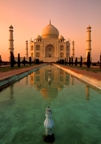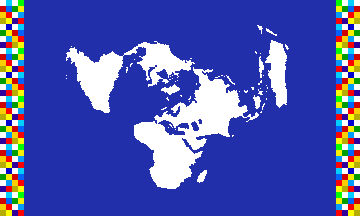

POLITICS

 |
POLITICS |
 |
The World in 2000 | Africa | Central America And The Caribbean | North America | South America | Antarctica
Central Asia | Eastern And South-Eastern Asia | South Asia | Europe | The Middle East | Oceania
Timeline | Differences | Politics | Science and Technology | Society | Notes | Summary | Home
This page is divided into the following sections:
Click on the section names to return to the top of the page.
There are a number of political systems and ideologies at work within Gurkani Âlam, often overlapping with one another. These include:
Gurkani Âlam is divided along lines broadly defined by religious ideology. However, rather than dividing along lines of which faith one adheres to, although this does happen to a lesser extent, divisions have occurred along the lines of how accepting one is of other faiths, how tolerant one is, and in particular how intolerant one is of other faiths. Over time, three distinct blocs have arisen:
The terms Dharmic and One Truth blocs were coined in 1870 by French political philosopher Fabrice Sertillanges as part of an analysis of the world political system.
An international secular organisation founded in 1850 following the Third Council of Rome with the intention of allowing discussion and negotiations between nations in a peaceful manner. This would hopefully allow the avoidance of war by providing a forum in which nations could address their grievances with one another in a neutral setting, possibly with mediation from neutral third parties. [As such the Oikoumene Council is roughly equivalent to the real world United Nations, though with a rather longer history.]
In terms of organisation, the Oikoumene Council consists of a council in which issues are raised and discussed, with subsidiary councils which discuss specific issues and raise them to the overall council if required; these subsidiary councils may be temporary or permanent and among other things form the basis for negotiations between nations under the auspices of the Council. The Oikoumene Council is funded by voluntary donations from the nations of the world
Over the years the Oikoumene Council has successfully mediated disputes in Europe, Africa, China, the Middle East and elsewhere, preventing or ending a number of wars. On the other hand it has also failed to prevent other wars, and in particular the Long War, although it made its best efforts to end this war as it proceeded, and also appealed for both sides in the war to not destroy the world with nuclear weapons, a plea that was largely listened to and abided by. Because of all of this the Oikoumene Council is fairly well-respected in the world [certainly more so than the United Nations of the real world].
It has also been responsible for:
Although not all of these rules have been adhered to, and in particular during the Long War, they have saved many lives over the years. Despite its best efforts the Oikoumene Council has been unable to achieve a universal ban on nuclear weapons or the use of space-based weapons such as the Qamari Mosht.
There have been attempts to give the Oikoumene Council more teeth to enforce its rules on the nations of the world, but so far all such proposals have been rejected by the majority of nations.
One of the failures of the Oikoumene Council is in their attempts to persuade the world to adopt a new, rational system of measurements to replace all of the different incompatible local systems used around the world [not unlike the Metric system of the real world]. This Oikoumene System was intended to help the nations of the world to cooperate and unify. However, it has never become widely adopted, and nations continue to use their traditional measurement systems.
Originally based is Isfahan in Persia, with the coming of the Long War the organisation was forced to find a new home, eventually moving its headquarters to Oranjeburg, the capital of Oranjestaat, where it has come to very much overshadow the Freethought Alliance, which is also based there.
The name of the organisation is derived from ecumene, a word meaning 'the inhabited part of the Earth', or the inhabited World, but which is also interpreted to mean simply the world as a whole.
The flag of the Oikoumene Council is a dark blue field with a white map of the world as viewed from the north pole centred on it [not unlike the view of the world presented on the flag of the United Nations in the real world]. Down each edge of it is a band of small squares filled with many different colours, representing the colours of the flags of the nations of the Earth.

An organisation that includes a number of nations with Vrijdenkerij (that is, atheist) governments which banded together in 1814 for mutual protection and trade. Since then it has evolved into a third lesser power bloc, occupying a middle ground between the Dharmic and One Truth blocs. Some Vrijdenkerij nations are tolerant of all faiths, but want none of them. Others actively work against all religions.
The Freethought Alliance has its headquarters in Oranjeburg, the capital of Oranjestaat, where since the Long War it has come to be very much overshadowed by the Oikoumene Council, which came to be based there in 1953. Even before that the Freethought Alliance was becoming weaker and weaker as the Oikoumene Council grew in influence.
Because of this it is now a discussion forum for a small number of nations only, which continues to be used out of tradition more than anything else.
Over the years reasonably close links have developed between France Équinoxiale and its Spanish-descended neighbours. As such they joined formally in 1844 into what in known as Le Pacte d'Amazone (The Amazon Pact), a loose mutual trade and defence pact. The members of the Amazon Pact currently include France, Casaquiarja and Peru, with Prussian Suriname and the nations of the Tucumán Pact as associate members. Political differences with Casaquiarja have prevented New Granada from joining the Pact.
A defensive alliance of the South American nations of Chaco, Chile and La Plata, founded in 1918, and named after the capital city of Chaco, where the Pact was signed. The three nations of the Pact are linked by their shared Spanish heritage, use of Sophocratic ideas in government (though none of them are actually Sophocracies), as well as their small size and lack of power relative to the great powers of the Anglo-Danish, French and Portuguese (now Brasealean) Empires. This latter is what drove them to link their fates via the Tucumán Pact, in the hope that it would make them a greater power in the world.
Having made unsuccessful attempts to claim more territory in the southern tip of South America, by diplomacy and the Patagonian War, this has not become the case.
During the Long War the nations of the Tucumán Pact had little choice but to bow to the demands of the Anglo-Danish and Brasealean Empires and fight against Scotland and France, helping to invade Mapuche and New Fife. However, as the Long War progressed, they were able to change sides returning Mapuche and New Fife to France and Scotland, joining Le Pacte d'Amazone as an associate member, and gaining territory in Braseal and Kingsland.
Since the end of the Long War the Tucumán Pact has maintained friendly relations with France and Scotland, and other nations of Le Pacte d'Amazone, with whom they now have strong economic and military ties.
A concept conceived by Alauddin Bakar Al-Haj, a colleague of Sultan Abdul Jalil of Johor, in 1833, who originally applied it to the Alam Melayu (Malay World. It proposes a political movement which would unify all Malay people everywhere, and all of the Malay Archipelago, into a single political entity superseding the current assorted Malay kingdoms.
Although not accepted by the Sultan of Johor, the Alam Melayu movement lead to similar ideas taking root in other parts of the world. A 'Celtic World' movement grew up in Scotland, Ireland and Wales, as well as others in Scandinavia, Germany under the name of the All-German Party, Italy and the Middle East.
Most of these movements came to nothing, but the Celtic World movement did cause enough unrest that, despite attempts to suppress it, the Anglo-Danish government had no choice but to grant more Welsh and Irish rights, give them limited devolution, and give their nations places on the Anglo-Danish flag. As part of this both Wales and Ireland became Dominions within Anglo-Denmark, and Ireland was granted a dispensation giving its Catholics equal rights with the other official religions in Ireland itself (as were Catholics in Maryland and Cuba within the Dominion of New England, and the entire Dominion of Mosquitia).
Despite denials by the Indian governments, it continues to be rumoured that the Mughal Empire and/or the Dakshina Nad have a secret organisation of assassins working for them who are descended from the Thuggees and who do the dirty work of the government.
There are a number of terrorist groups operating in the world, in particular Uzbek separatists, and many others funded by both sides in the Long War and who have now gone their own way.
One major influence in the modern politics of many nations are the secret police and intelligence services of those nations. Having built up their power and influence during the Long War, with its end many of their governments wish to reduce their power again, something that those in charge of many of these organisations wish to avoid. Because of this many national governments are engaged in covert struggles between their nominal authorities and their secret services.
The World in 2000 | Africa | Central America And The Caribbean | North America | South America | Antarctica
Central Asia | Eastern And South-Eastern Asia | South Asia | Europe | The Middle East | Oceania
Go to the Gurkani Âlam Timeline, Differences, Politics, Science and Technology, Society, Notes or Summary Pages.
Back to the Gurkani Âlam Home Page.
 |
Copyright © Tony Jones, 2007.
This work is licensed under a Creative Commons Attribution-Noncommercial-Share Alike 3.0 License. |